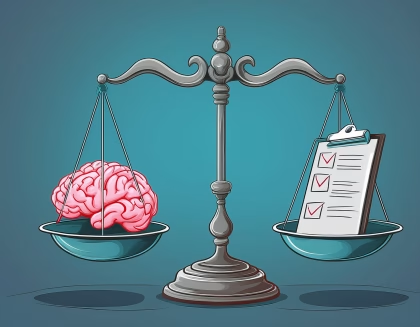The COVID-19 pandemic reaffirmed that healthcare professionals (HCPs) are extremely valuable to the health of society. We realize how risky their work can be and how difficult it is for them to perform well and make critical decisions under stressful situations.
The current situation has made it clear that more research resources need to be allocated to healthcare applications to improve HCP performance and processes of diagnosis as well as treatment. To that end, biosensor tools have been often used to enable reliable multimodal research in both labs and natural settings. Researchers have used biosensors to innovate and improve diagnostic processes.
This includes studying factors that influence HCP’s work interactions and performance. Below are four inspiring application cases of biosensor research that we think are pioneering the future of healthcare research.
1. Emergency Care Simulations Provide Information on HCP’s Performance by Analyzing Eye Tracking: Gaze Patterns
This recent interdisciplinary collaboration focused on a Health Care Professional’s situational awareness during an emergency simulation (2020). A team of researchers from Yokohama City University, Kyushu Institute of Technology, and Nottingham University collaborated to analyze an emergency doctor’s decision-making from his gaze behavior, using eye-tracking glasses and iMotions software. This study is part of the Japan-UK Eyework Project, aiming to investigate how HCPs in emergency care achieve intersubjectivity and use emergency interaction as a social action (1).

The most recent study from the project took place in a natural hospital setting, with two other doctors, and a mock patient having a brain hemorrhage. The doctor needed to perform as normal in this unexpected emergency situation, while researchers were observing his gaze data in real time.
They found that the team leader’s gaze was more frequently on his teammates’ bodies than their faces when making requests, and they used this information to quantify and describe HCP interactions. Gaze patterns turned out to signal how the leadership works within the medical team, showing how the leader was gazing at their teammates repetitively before making requests, and was observing them during and after the actions too.

This study is a pioneer to establishing a standard methodology using eye tracking glasses, and possibly other biosensors to train HCP’s behaviors in emergency situations and improve performance. Wearable sensor technologies such as eye tracking glasses make it possible to study HCP behavior in a naturalistic setting, thereby increasing the generalizability of results and gaining insights that are immediately applicable to real-life situations.
2. Biosensors Provide Increased Insights on Usability Testing of Medical Devices
Devices used in hospitals are crucial for fast diagnosis and treatment of many different diseases. These devices can be quite sophisticated and complex for the user. Given hectic hospital environments, healthcare workers need medical devices that have intuitive designs and clear user instructions. Applied psychology researchers from FORCE Technology in Denmark, worked on easing this problem by studying how to improve the usability studies of medical devices using eye tracking glasses (2).
Thomas Koester and colleagues posited that eye tracking can provide a window into the perception of the user when interacting with a medical device. This is often not achieved with traditional methods of UX research such as video observations, post-use interviews, and surveys, which are prone to biases and errors.
Koester’s study procedure involved having participants use an undisclosed medical device (for confidentiality reasons) in two scenarios, one where the user tries to identify the device status (i.e. if the device is ready to use) and the other where the user decides if the device needs maintenance or not. They also compared the findings to a parallel observation using traditional ethnographic methods for usability testing.
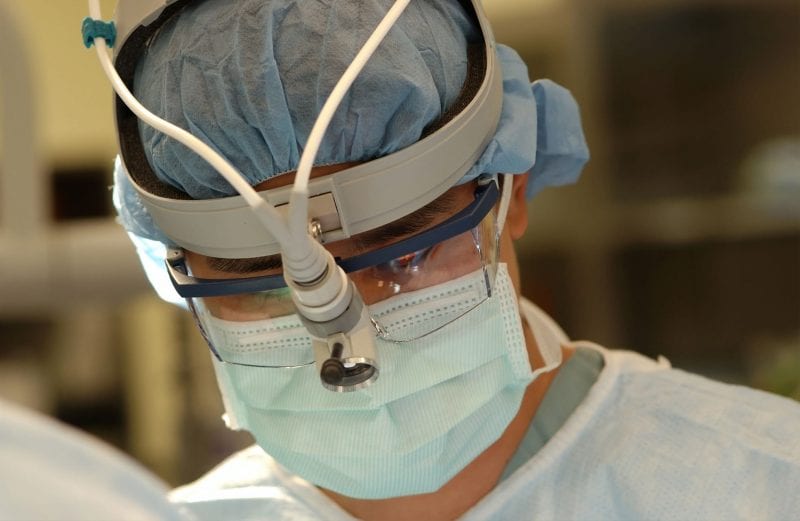
To analyze the eye tracking data, the researchers used heat maps and areas of interest (AOI) functionalities in iMotions.
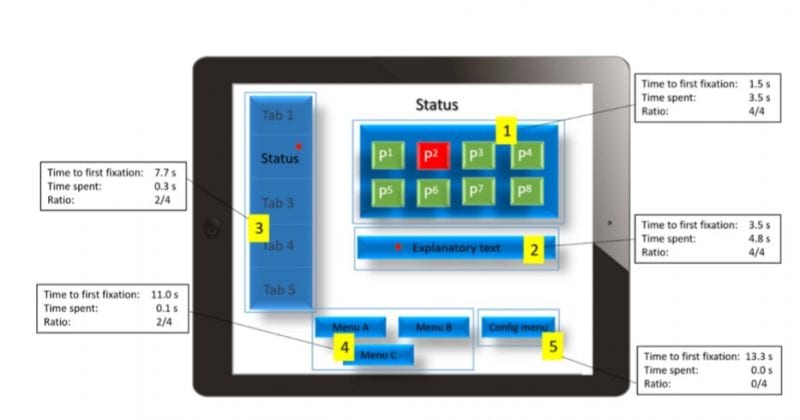
Gaze map aggregating four participants’ use of eye-tracking. The figure is not an illustration of the actual device. It is for illustration purposes only.
The final evaluation showed that eye tracking glasses provided faster and more detailed results with additional insights. It was found that the group that used eye tracking glasses could obtain at least five additional insights that weren’t obtained by the traditional method team. For instance, they noticed that the facilitator’s papers were distracting to the user while the initial information was being communicated.
Another observation was that none of the participants looked at an important button on the device. Moreover, the researchers could find out that the participants with prior experience with similar devices showed reduced performance.
Through these insights, it became possible to find out the root cause of user’s errors, and how the user’s attention was distributed throughout the tasks.
In conclusion, eye tracking glasses and real-time data synchronization significantly improve usability research for medical devices, making it possible to study these devices in their real and natural scenarios.
3. Biosensors can Reveal Impaired Cognitive Dysfunctions in Parkinson’s Disease
Parkinson’s disease (PD) is one of the most studied neurological disorders among research groups today. Researchers have detected that this disease presents impaired face and emotion processing. In addition, the 40% of patients who suffer from it can also develop dementia (PD-D) (Padovani et al. 2006) (3). However, this deficit of face processing remains unclear in PD-D patients.
The China Medical University of Taichung (Taiwan) ran a study about how impairments in face discrimination and emotion recognition are related to aging and cognitive dysfunctions in Parkinson’s disease with dementia (4). They have investigated three essential aspects of face processing capacity and the associations between cognitive, neuropsychiatric assessments and task performances by working with PD-D patients and healthy control.
Respondents had to do three computerized tasks: face discrimination, emotion recognition and expression imitation, in which they were using the iMotions software with the facial expression analysis module provided in partnership with Affectiva. Their findings indicate that impairment of recognizing negative emotions persisted from PD to the PD-D stage.
This study was among the first few exploring three important aspects of face processing in patients with PD-D. They found consistent deficits correlated with advancing age and slow mentation. Their results concluded that a face discrimination task could be used as a potential test for the early detection of dementia in PD.
Let’s talk!
Schedule a free demo or get a quote to discover how our software and hardware solutions can support your research.
4. Biosensor Research can Improve Therapeutic Interactions by Analyzing Emotional Expressions of Care Givers
The role of emotions in decision making has been investigated for decades. Recent studies have shown that these emotions, associated with muscle activation, are the dominant engine of most of the significant decisions we make every day. However, not much information is available about how this facial muscle activity, and its derived emotional expression, are related to the therapeutic decisions that physicians make every day in their consultations.
In addition, there is a very common phenomenon that affects doctors who care for patients with chronic conditions, called Therapeutic Inertia (TI), which defines the absence of treatment initiation or intensification when there is clear evidence of clinical and radiological activity of the disease. This phenomenon often leads to poorer clinical outcomes and higher healthcare costs.
That’s why the “Decision Neuroscience Unit” of the University of Toronto in collaboration with the University of Zurich decided to carry out a study to define how and what type of emotional expressions are associated with therapeutic decisions in multiple sclerosis (MS) patients care.
To do this, they evaluated the relationship between emotions and affective states, and TI (Therapeutic Inertia) among neurologists who care for these MS patients, while they are making their therapeutic decisions. Specifically, the study was carried out with neurologists with expertise in MS, who were asked to answer various questions about their clinical practice, aversion to ambiguity, and the management of different simulated case scenarios (5).
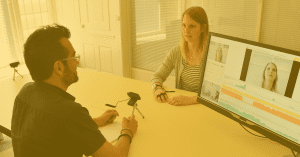
They recorded facial muscle activations and their associated emotional expressions during the study by using the iMotions software with the AFFDEX Affectiva module. They found that half of the participants showed TI in at least one of the case scenarios. This suggests that facial metrics and emotional expressions are associated with physicians’ choices and partially mediate the effect of aversion to ambiguity on TI.
Therefore, they propose that identifying and administering appropriate educational interventions in such situations can facilitate optimal therapeutic decision making in chronic diseases, resulting in better results for patients and lower costs of medical care.
Check out our Webinar Healthcare Training in Virtual Environments with Varjo
Conclusion:
As the studies above indicate, biosensor tools and multimodal research can be powerful assets in a range of healthcare applications. These studies in healthcare communication, device usability testing, early diagnosis of Parkinson’s disease and treatment for multiple sclerosis can serve as important guides and inspirations for future research in similar areas in healthcare and performance. These are just a handful of examples, among many studies, showing the potential benefits of a multimodal approach in healthcare applications.
Contributing Writers:
Demet Soyyilmaz & Ariadna Hidalgo Pons
Download iMotions
Medical / Healthcare Brochure
iMotions is the world’s leading biosensor platform. Learn more about how iMotions can help you with your medical / healthcare research.
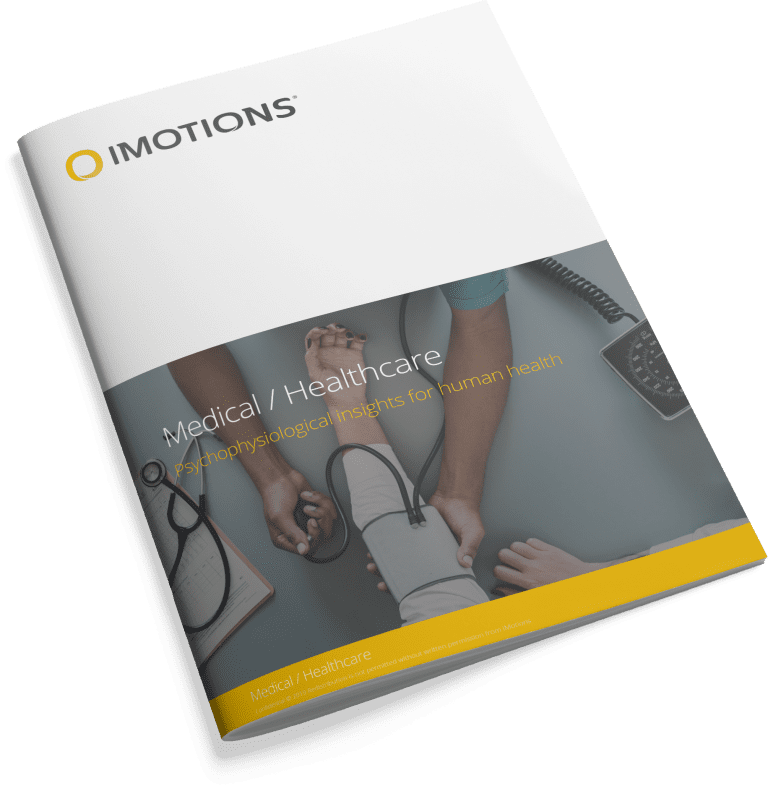
References
- Nakamura, K., Sakai, T., Abe, T., Saitoh, T., Coffey, F., MacKenzie, A., … & Tsuchiya, K. (2020). A team leader’s gaze before and after making requests in emergency care simulation: a case study with eye-tracking glasses. BMJ Simulation and Technology Enhanced Learning, bmjstel-2019.
- Koester, T., Brøsted, J. E., Jakobsen, J. J., Malmros, H. P., & Andreasen, N. K. (2017, June). The Use of Eye-Tracking in Usability Testing of Medical Devices. In Proceedings of the International Symposium on Human Factors and Ergonomics in Health Care (Vol. 6, No. 1, pp. 192-199). Sage CA: Los Angeles, CA: SAGE Publications.
- Padovani, A., Costanzi, C., Gilberti, N. & Borroni, B. Parkinson’s disease and dementia. Neurologic Science. 27, 40–43 (2006).
- Ho, M.W., Chien, S.H., Lu, M. et al. Impairments in face discrimination and emotion recognition are related to aging and cognitive dysfunctions in Parkinson’s disease with dementia. Sci Rep 10, 4367 (2020).
- Saposnik, G., Oh, J., Terzaghi, M., Kostyrko, P., Bakdache, F., & Montoya, A. et al. (2019). Emotional expressions associated with therapeutic inertia in multiple sclerosis care. Multiple Sclerosis And Related Disorders, 34, 17-28.





